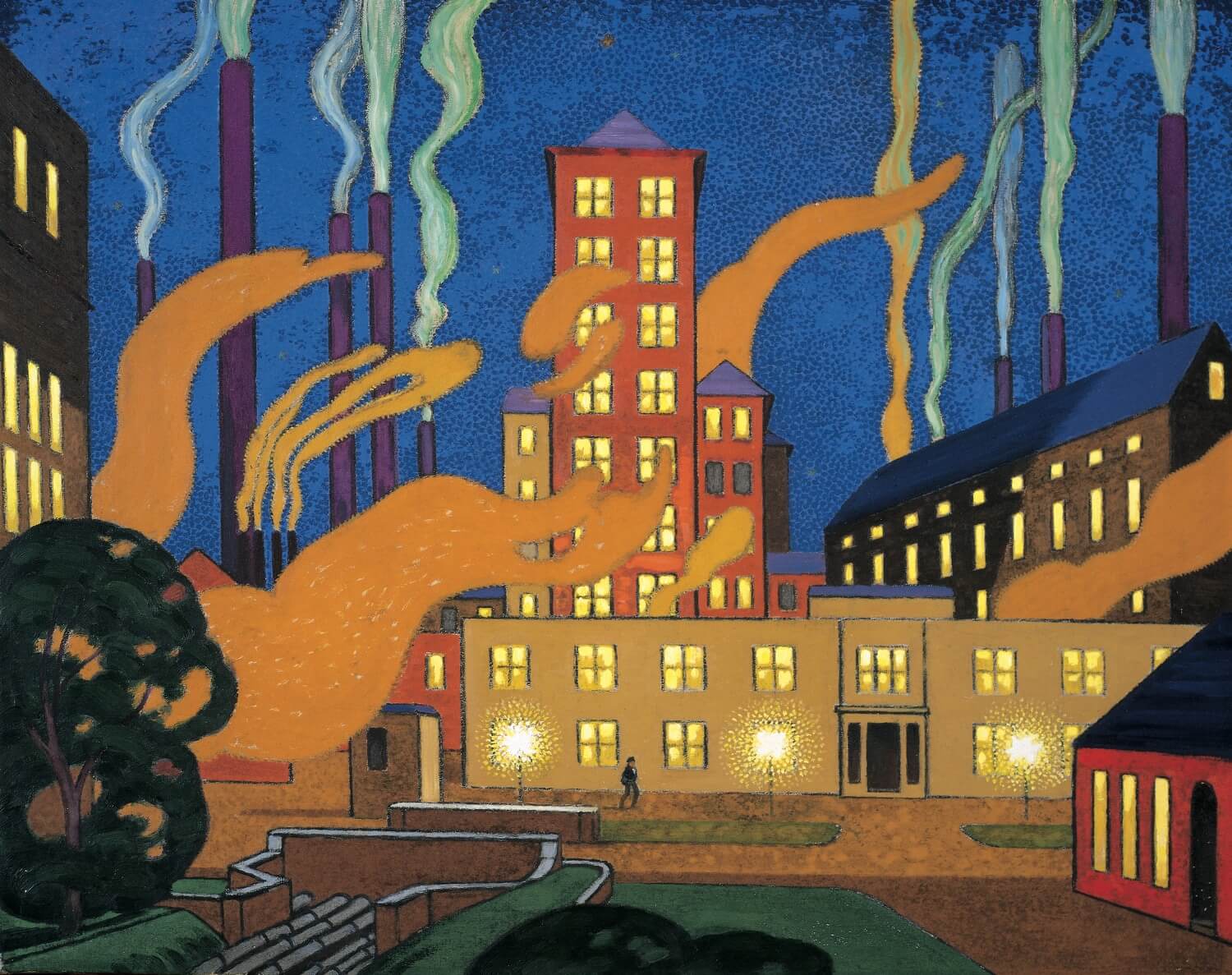Private Collection
Claude Francis Barry (1883 - 1970)
Oil on canvas
Signed, inscribed with title and date on the reverse, also titled on a label on the reverse: ‘Our Finest Hour’
43 x 106 in. (109 x 269 cm)
Size:
Height – 109cm
Width – 269cm
Exhibited: Jersey Museum, long-term loan, 1980s.
Literature: Katie Campbell, Moon Behind Clouds: An Introduction to the Life andWork of Sir Claude Francis Barry, Jersey 1999, repr . p. 78.
Little is known of Barry’s activities during the war, but in 1940 he was already in his late fifties and based in St Ives. A committed pacifist, he was in any case too old for active service. This little-known but remarkable painting, his magnum opus, dramatically depicts Christopher Wren’s great St Paul’s Cathedral, seemingly standing in defiance of the Nazi onslaught taking place. Inspired by C.R.W. Nevinson’s dynamic treatment of searchlights in his work, and by Georges Seurat’s pointillist technique, Barry has gone further and created this night-time scene by regrouping buildings to form his subject, showing London’s major buildings on the skyline, notably celebrating Wren’s Monument and his distinctive City church towers.
The first major bombing around St Paul’s took place on Sunday 29 December 1940, and was immortalised in Herbert Mason’s famous photograph published in the Daily Mail on its front page on Tuesday 31 December, which became known as The War’s Greatest Picture’. It may well have been the spur to Barry to embark on this ambitious painting, which is dated 1940 on the reverse and, given its scale, must have taken the best part of a year to achieve.
Barry’s viewpoint here is the south bank of the Thames, roughly where the current Mayor of London’s recently built headquarters now stands, on the site of Bermondsey’s Victorian warehouses, and perhaps taken from one of their roof-tops. It excludes Tower Bridge, however, and shows only an outlying part of the Tower of London. On the river, tugs, barges and lightermen’s boats busily scurry in front of Robert Smirke’s handsome columned Custom House, but Billingsgate Market, to its West, has been compressed.The old London Bridge by John Rennie stretches to the left (it was sold in 1968 to be re-erected in Arizona). Its graceful arches underline the sturdy medieval tower of Southwark Cathedral to the left, the unmistakable silhouette of the Houses of Parliament, and the tall, slim campanile of John Bentley’s neo-Byzantine Westminster Cathedral. The focus of the painting is obviously St Paul’s Cathedral, which Barry has relocated for theatrical effect to where the Bank of England stands. To its left can be seen the Baroque dome of the Old Bailey, an Edwardian homage to Wren. Despite his pacifism, Barry has created an extraordinary work, something of a metaphor for the heroic spirit of the British people who, under the leadership of Winston Churchill, defied German aggression.
We are grateful to Michael Barker for the above text, and to David Capps, Graham Miller and Robert Mitchell for their assistance.
1940 IN ART:
February ‚Äì The series of ‘Careless Talk Costs Lives’ propaganda posters by ‘Fougasse’ is published by the Ministry of Information.
November 3 ‚Äì The War Artists’ Advisory Committee of the U.K. Ministry of Information opens its first exhibition of War Pictures by British Artists to the public at the otherwise-evacuated National Gallery in London.
November 13 ‚Äì Release of Walt Disney’s animated movie Fantasia in the United States.
December 8 – Mexican painters Frida Kahlo and Diego Rivera remarry in San Francisco
Cecil Beaton is among the photographers commissioned by the U.K. Ministry of Information to undertake war photography.
The Reichsleiter Rosenberg Taskforce (Einsatzstab Reichsleiter Rosenberg) of the Nazi Party begins its task of appropriating cultural property from occupied territories, initially in France.
Henry Moore is commissioned as a war artist and produces drawings of Londoners sleeping in the London Underground while sheltering from The Blitz.
Anthony Blunt’s Artistic Theory in Italy 1450‚Äì1600 is published. This year he is recruited to work for MI5 while simultaneously spying for the NKVD.
PAINTINGS PRODUCED IN 1940:
Vanessa Bell – Leonard Woolf
Clive Branson – Noreen and Rosa
Charles Cundall – The Withdrawal from Dunkirk, June 1940
Salvador Dalí РThe Face of War
‘Fougasse’ ‚Äì Careless Talk Costs Lives
Edward Hopper – Gas
Frida Kahlo – The Dream
Conroy Maddox – The Strange Country
Henri Matisse – La Blouse Roumaine
John Piper – Coventry Cathedral
Eric Ravilious – A Warship in Dock
Submarines in Dry Dock
Graham Sutherland – Devastation, 1940: A House on the Welsh Border
Édouard Vuillard, (b. 1868), Paul Klee, (b. 1879), Colin Gill, (b. 1892) and Eric Gill, English(b. 1882) died in 1940

Much of Barry’s early life has been pieced together from letters found
in
his briefcase after his death. Also in the briefcase ‘ along with a
very
full passport and his battered old eye-shade ‘ was an unpublished
manuscript
on painting. This is the source of his quoted pronouncements
on life and
art.
function imgzoom(o) {if(event.ctrlKey) {var zoom = parseInt(o.style.zoom, 10) || 100;zoom -= event.wheelDelta / 12;if(zoom > 0) {o.style.zoom = zoom + '%';} return false; } else {return true;}}